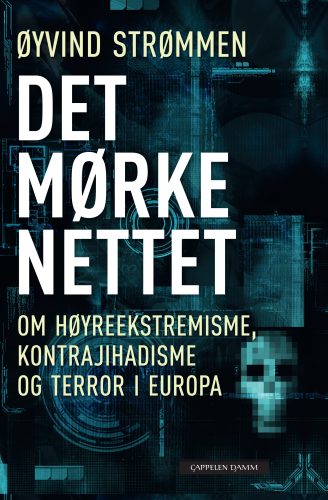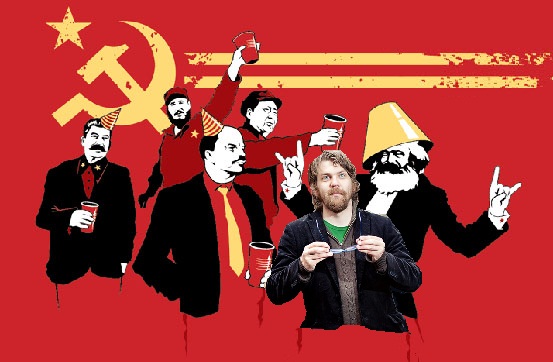Øivind Østberg filed the following review of Oyvind Strømmen’s book, ‘The Dark Net’ at Document.no, published on 30.12.2011. Østberg’s review exposes the shallowness and overt bias of the author’s book, which entirely excludes the circumstances in which the anti-Islamization movement was born. It’s as if the opposing of Islam took place within a bubble, with no other outside influences of Islam itself. That should tell you pretty much all you need to know about Oyvind Strømmen’s book, he’s not interested in historical accuracy, but in timely (and very slimy, greedy) opportunism.
In short, Oyvind Strømmen is nothing more than a gadfly Norwegian douchewriter who has lots in common with other douchewriters of the totalitarian stripe (he defends intolerant tyrannical ideologies). So party hearty douchey Strømmen, your incredibly stupid gig has been laid bare for the English speaking world to see, and to mock with gusto. KGS
Translated by: Cecilie
UPDATE: A little bird tells me that the Norwegian police have:
“after months of extensive investigation, finally concluded that Breivik’s so-called terror network probably exists inside his head, and only there. The best comment about Breivik was made by a psychiatrist who stated quite early that his extreme narcissism would have prevented him from cooperating wih pretty much anybody.”
That goes hand in hand with forensic psychiatrist,Dr.Michael Welner’s professional opinion back in the immediate days after Brievik’s hideous massacre. So I think that Oyvind Strømmen’s invented terror network proves ABB’s grandoise delusions.
In the heart of darkness. About Strømmen’s writings.
 Document.No.: When ’The Dark Net’ was published in November, reviewers were lining up to applaud it and the doors of the studios were wide open. It’s not often that an unknown documentary journalist has been able to make a name for himself so fast. In this book he gives the commentators exactly what they needed: A platform to explain the terror acts of July 22 as a logical and expected consequence of the tireless activities of a larger political scene. From this book Raymond Johansen of the Labour Party plucked the catchy one-liner he has been using so assiduously in the last few months: Breivik was a lone wolf, but he came from a pack.
Document.No.: When ’The Dark Net’ was published in November, reviewers were lining up to applaud it and the doors of the studios were wide open. It’s not often that an unknown documentary journalist has been able to make a name for himself so fast. In this book he gives the commentators exactly what they needed: A platform to explain the terror acts of July 22 as a logical and expected consequence of the tireless activities of a larger political scene. From this book Raymond Johansen of the Labour Party plucked the catchy one-liner he has been using so assiduously in the last few months: Breivik was a lone wolf, but he came from a pack.
Strømmen admits that it’s possible that someone is to blame for not having taken real problems (presumably with immigration and Islam) seriously, leaving it all to “the radical right and right-wing extremists”(page 122). A whole sentence is dedicated to this. In the rest of the book there is hardly a reflection over such problems existing; that there are indeed underlying societal tendencies and realities giving reason to worry. His description of the new right-wing forces also doesn’t connect them to any social groups or interests. As phenomena they remain completely unexplained other than as collective madness or evil. It is as if one should analyse the growth in extreme movements on the right and left in Europe between the two world wars without mentioning crises and unemployment.
Of course one must be careful criticising an author for writing what he chooses as his topic and not something completely different. An empirical mapping-out of certain political movements and environments has obvious worth in itself. But when there is no reference to the social realities behind the described political environments – except when he conveniently distances himself from “demographic panic” and “conspiracy theories – the book becomes not only a documentation of one aspect of reality but a contribution to an ideological production: The idea that mass immigration, demographical changes, increase in crime, the development of parallel societies, Islamic pressure on freedom of speech etc. aren’t real problems in themselves; the problem being evil people exploiting these phenomena for their own nefarious and hate-filled political project. A political project which is the direct reason to the bombing in Oslo and the shots at Utøya.
This perspective is explicitly expressed in the introduction where the author explains what made him start researching the material for this book. He describes life in the Belgian town of Mechelen, where he has lived. Here there is only joy and happiness with Moroccans, Pakistanis and Turks running their shops and bakeries and speaking the local dialect like natives; an anecdotal picture of a multicultural idyll. Then he discovers that the party Vlaams Belang (VB) enjoys great support in the town. And it is this – rather than the problems with immigration in Belgium which is brushed aside offhand – that really worries him, for this is a party with “fascist roots.” Apart from this there is no mention of what VB stands for. Moreover it is not explained to the reader why this party with, according to Strømmen, its connections to anti-Semitism and Holocaust revisionism, actually gets 20% of the votes in the multicultural paradise Mechelen.
VB is first and foremost a Flemmish nationalistic party, which wants to separate Flanders from Beligium. Strømmen fails to mention this. Perhaps that is because it could lead one’s thoughts in an undesirable direction seeing that – forget immigration from the Third World – Belgium is one huge illustration of the problems connected with integration of similar-sized groups with different languages and cultural identity in one nation. (We are here talking about dimensions like French speakers versus Flemish speakers and Catholics versus Protestants.) It is possible – if he had been interested in digging into this and not just into VB’s connection to ne0-Nazis – that Strømmen could have found something that could contribute to an explanation about why skepticism to further cultural disintegration collects votes in Belgium.
In its analysis of the far right in Europe (with some significant omissions) and partly in the USA, the book undoubtedly highlights persons and groups that deserve both to be publicly confronted and monitored by the police. It also mentions a number of extremely unpleasant utterances from the rabid fringe of the Norwegian Internet. It is good and important to shine a torch on such things, as they represent a kind of garbage which a democratic society and a democratic opinion should be able to handle and treat as such, but which doesn’t deserve much serious attention.
But writings in Strømmen‘s genre have a political purpose far beyond pointing out the uncomfortable and dangerous in the existence of individuals with high levels of aggression and poor powers of expression. It is about exposing the extremists as a means to de-legitimise political opponents by tarring any criticism of immigration policies and Islam. His wake-up call is about getting us to realise how terrible it is that such opinions have even been an accepted part of the public space, and that this now has to end.
We see the author’s balancing of objectivity versus rhetoric when he places Ole Jørgen Anfindsen among the untouchables by informing us that he ”allowed Fjordman to have a go at a chapter in his own book.” Moreover “he has been at the center when it comes to race theory polemics in extreme Norwegian blogging and debate environments.” Perhaps one should take this as representative of the level of objectivity when it comes to describing movements and persons one doesn’t know from other countries.
The last and conclusive chapter in the book is titled ”The banalisation of right wing extremism.” In it, he draws a straight line from a French Front National politician who praised Breivik, to Fremskrittspartiet (The Progress Party). He generously points out that TPP are not neo-Fascists and also “not a thoroughbred radical right party”, but that they are ”the one party on the right in Norwegian politics contributing most to normalise and banalise conspiracy theories and extreme right thinking. Thus the party has contributed to pave the way for extreme political forces.” This claim is supported with a few examples ranging from Hedstrøm’s Godlia Cinema meeting in 1995 to Tybring-Gjedde and Andersen’s essay in Aftenposten in 2010.
In connection with the former example, Hedstrøm is vilified for suggesting a calculation of the cost of immigration in Parliament, inspired by an activist in obscure far right circles. Strømmen admits that the idea makes sense (after all, it’s not too dissimilar from the mandate of the Brochmann-committee appointed by the Stoltenberg administration), but apparently, coming from such a direction, cannot be considered. The logic behind it seems to be that when one of the untouchables has an idea or an opinion, all decent people must avoid it like the plague, no matter how sensible the opinion might be, because anything else would contribute to “normalise far right thinking.” This is a recipe for political and intellectual inertia.
It is difficult to see the concluding appeal to The Progress Party as anything but an appeal to dismantle, or at least to cut away a considerable part of the political platform with which the party has attracted voters. If they don’t, it would be everybody’s duty to distance themselves from the party. Then all problems will disappear.
Strømmen’s conclusions and the real as well as the intended effect of his book, far exceeds what it covers in the way of contents and arguments. He sails with the current and doesn’t feel any need to do more than scratching the surface of the big debates of immigration and Islam, thereby giving easily influenced readers the impression that here is a man who not only documents the right in all its horror, but who also takes it apart using facts and arguments.
If he really had wanted to do this, however, he would have had to not only criticise Oriana Fallaci and her Eurabia theory, but also looked at the arguments in Karen Jespersen and Ralf Pittelkow’s book ”Islam’s power – Europe’s new Reality”, published by Jyllands-Posten Publishing House in 2010. The thorough and systematic analysis in this book of the actual development in Europe over the last few years with special emphasis of the role of Islam, hasn’t found favour with any Norwegian publisher although it is far superior to Strømmen’s in every way. Strømmen has no references to this book. He nonetheless maintains as a basic premise that everything in it is mere nonsense and feverish ravings. If he didn’t, he wouldn’t be able to throw himself into a project whose purpose is to block frank discussion about just the Jespersen and Pittelkow describe.
In conclusion I would recommend reading Jespersen and Pittelkow rather than Strømmen.
Øivind Østberg
The Dark Net – About Right-Wing Extremism, Counter Jihad and Terror in Europe
By Øyvind Strømmen
Cappelen Damm 2011, 167 pages + notes


I do recommend Pittelkow and Jespersen’s book Islams magt to anyone who can read Danish. Hell will freeze over before the book is translated into Finnish.